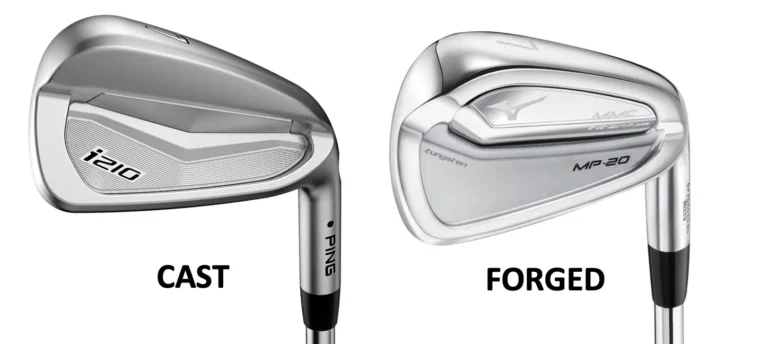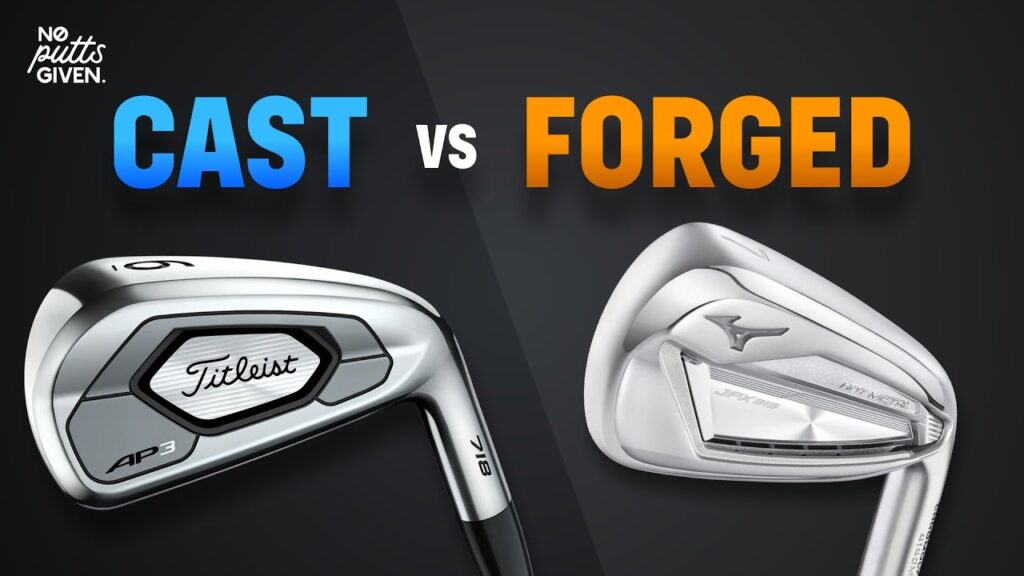Ready to step up your golf game? If you’ve ever wondered about the difference between forged and cast irons, you’re in the right place. Whether you’re a seasoned golfer or just getting started, understanding the variances between these types of clubs can greatly impact your performance on the course. From their manufacturing processes to their performance characteristics, we’ll explore everything you need to know about forged and cast irons. Get ready to elevate your swing to the next level!
Definition of Forged Irons
Forged irons are a type of golf club that is made through the process of forging. This technique involves shaping the clubhead by heating a solid piece of iron and then hammering it into the desired form. The result is a clubhead that has been carefully crafted to maximize performance and precision.
Process of forging
The process of forging involves heating a piece of iron until it reaches a malleable state. This is typically done in a controlled environment, such as a forge, where the iron can be heated to a specific temperature. Once the iron is hot enough, it is placed on an anvil and carefully shaped using a hammer. This process allows for greater control over the clubhead’s shape and the distribution of weight, resulting in a more precise and consistent performance.

Characteristics of forged irons
Forged irons are known for their exceptional feel and feedback. The forging process creates a denser grain structure in the metal, which enhances the club’s ability to transmit vibrations to the golfer’s hands. This allows for better feedback on each shot, enabling the golfer to make adjustments and improve their swing. Additionally, the precise shaping of forged irons allows for better weight distribution, leading to improved accuracy and control.
Definition of Cast Irons
Cast irons, on the other hand, are created through a process called casting. This technique involves pouring molten metal into a pre-constructed mold, which is later cooled and solidified. The resulting clubhead has a slightly different composition and structure compared to forged irons.

Process of casting
Casting begins with the creation of a mold, typically made from a mixture of sand and clay. The mold is then shaped to resemble the desired clubhead design. Once the mold is prepared, molten metal, usually a combination of iron and other metals, is poured into the mold and left to cool. As the metal cools and solidifies, the mold is removed, leaving behind the cast iron clubhead.
Characteristics of cast irons
Cast irons tend to have a more uniform and consistent structure compared to forged irons. This can result in a more predictable performance, as the weight distribution is often more standardized throughout the clubhead. However, cast irons may not offer the same level of feel and feedback as their forged counterparts. This is due to the less dense grain structure in cast irons, which can dampen vibrations and reduce the golfer’s ability to accurately assess the impact of each shot.

Manufacturing Process
Forged Irons Manufacturing Process
The manufacturing process for forged irons involves several steps. First, a piece of iron, known as a billet, is heated to a specific temperature to make it malleable. The billet is then placed on an anvil and hammered into shape using a mechanical or hydraulic press. The iron is repeatedly struck to achieve the desired clubhead shape, and any excess material is carefully removed. Finally, the clubhead is finished by grinding and polishing to ensure a smooth surface.
Cast Irons Manufacturing Process
The manufacturing process for cast irons begins with the creation of a mold, as mentioned earlier. The mold is typically made from a mixture of sand and clay, which is carefully shaped to resemble the desired clubhead design. Once the mold is ready, the molten metal is poured into it, filling the cavity completely. After the metal cools and solidifies, the mold is removed, and any excess material is trimmed and polished to create the final clubhead.
Strength and Durability
Forged Irons Strength and Durability
Forged irons are known for their strength and durability. The process of forging creates a denser grain structure in the metal, making it more resistant to bending and warping. This allows the clubhead to withstand the impact of strong swings without compromising its shape or performance. Additionally, the precise shaping of forged irons ensures that the weight distribution is optimized, contributing to their overall strength.
Cast Irons Strength and Durability
While cast irons are generally durable, they may not possess the same level of strength as forged irons. The casting process results in a more uniform structure, but it may not have the same level of density and integrity as forged irons. As a result, cast irons may be more prone to bending or warping under the force of a powerful swing. However, advancements in casting technology have improved the strength and durability of cast irons, making them a viable option for many golfers.

Flexibility and Control
Forged Irons Flexibility and Control
Forged irons offer excellent flexibility and control on the golf course. The precise shaping of the clubhead allows for better weight distribution, which enhances the golfer’s ability to control their shots. The malleable nature of forged irons also allows for more customization in terms of loft and lie angle adjustments, further enhancing the club’s flexibility. This adaptability enables golfers to fine-tune their playing style and optimize their performance.
Cast Irons Flexibility and Control
While cast irons may not offer the same level of flexibility and control as forged irons, they still provide a reliable level of performance. The standardized weight distribution in cast irons contributes to consistent ball flight and trajectory. However, the limited customization options in terms of loft and lie angle adjustments may affect a golfer’s ability to fine-tune their game. Nevertheless, many golfers find that cast irons still provide a satisfactory level of flexibility and control.
Forgiveness and Distance
Forged Irons Forgiveness and Distance
Forged irons are often praised for their forgiveness and shot-making capabilities. The precise shaping and weight distribution of forged irons allow for a larger sweet spot, minimizing the negative effects of off-center strikes. This forgiveness translates to greater consistency and accuracy, helping golfers achieve more predictable distances with each shot. Additionally, the enhanced feel and feedback of forged irons contribute to better shot control and the ability to shape shots according to the golfer’s intentions.
Cast Irons Forgiveness and Distance
Cast irons are also designed with forgiveness in mind, although they may not offer the same level of shot-making capabilities as forged irons. The standardized weight distribution and larger sweet spot in cast irons help minimize the impact of off-center strikes, contributing to more forgiving shots. The consistent structure of cast irons also allows for a predictable distance with each swing, albeit with potentially less shot control and feel compared to forged irons.

Feel and Feedback
Forged Irons Feel and Feedback
One of the defining features of forged irons is their exceptional feel and feedback. The denser grain structure created through the forging process allows for better transmission of vibrations from the clubhead to the golfer’s hands. This provides golfers with crucial feedback on the quality and impact of each shot, enabling them to make adjustments and improve their swing. The enhanced feel of forged irons also contributes to a more enjoyable and satisfying experience on the course.
Cast Irons Feel and Feedback
While cast irons may not offer the same level of feel and feedback as forged irons, they still provide a satisfactory level of performance. The solid structure of cast irons dampens the vibrations transmitted to the golfer’s hands, resulting in less feedback compared to forged irons. However, many golfers find that cast irons still provide an adequate level of feel and feedback, allowing them to assess the quality of their shots and make necessary adjustments.
Customization and Adjustability
Forged Irons Customization and Adjustability
Forged irons often offer a higher level of customization and adjustability compared to cast irons. The malleable nature of forged irons allows for easier bending and loft-lie adjustments to fine-tune the club’s performance. Golfers can work with club fitters or professionals to personalize their forged irons, optimizing their playing style and preferences. This level of customization and adjustability is highly valued by golfers who seek to achieve the ideal club fit for their game.
Cast Irons Customization and Adjustability
Cast irons generally offer limited customization and adjustability compared to forged irons. The casting process results in a more fixed structure, making it more difficult to make significant changes to the club’s specifications. However, cast irons often still provide options for basic adjustments such as grip size or shaft selection to accommodate a golfer’s preferences. While not as versatile as forged irons, cast irons can still be tailored to some extent to suit individual golfers.
Pricing
Forged Irons Pricing
Forged irons tend to be more expensive than cast irons due to the intricate manufacturing process involved. The labor-intensive nature of forging, along with the premium materials used, contribute to the higher cost of forged irons. Additionally, the level of customization and adjustability offered by forged irons can further increase the price. However, many golfers believe that the superior performance and quality of forged irons justify the higher price point.
Cast Irons Pricing
Cast irons are generally more affordable compared to forged irons. The casting process allows for more efficient production, resulting in lower manufacturing costs. This affordability makes cast irons a popular choice for golfers looking for quality clubs at a more budget-friendly price. While they may not offer the same level of performance as forged irons, cast irons are often seen as a cost-effective option that still delivers satisfactory results on the course.
Conclusion
In conclusion, the difference between forged and cast irons lies in the manufacturing process, resulting characteristics, and overall performance on the golf course. Forged irons offer exceptional feel, feedback, flexibility, control, forgiveness, and customization, but come at a higher price point. On the other hand, cast irons provide affordability, durability, forgiveness, and reliable performance, although they may lack some of the finer qualities associated with forged irons. Ultimately, the choice between these two types of irons depends on the golfer’s preferences, playing style, and budget. It’s important to try out different clubs and consult with professionals to find the irons that best suit your needs and help you achieve the best possible game.






